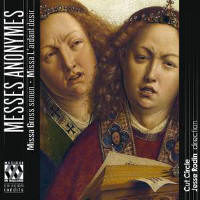Texte paru dans: / Appeared in: |
|
|
Outil de traduction |
|
|
Reviewer: J.
F. Weber
Jesse Rodin’s booklet notes, written in collaboration with Emily Zazulia, his “scientific collaborator,” are titled “Two Difficult Masses.” The first one, Missa Gross senen, is found in Trent 89 and was copied around 1468, while the other, Missa L’ardant desir, survives in Cappella Sistina 51, where it was copied before 1488. Both Masses are anonymous, both sources are unique, and both are prone to error, the former “riddled” with them; it is based on a folksong, the other on a love song, and both tunes are notated in the respective tenors. One is based on Gross senen ich in Herzen trag, the other on an unknown love song that David Fallows has reconstructed from the Mass tenor (the tune, at least). It is soon clear why difficulty is the key to this pairing. This project emerged from a conference at Berkeley three years ago on difficulty in music. I suspect Rodin leaped at the chance to tackle these manuscripts and record the Masses for the first time, for the sessions soon followed. Nowhere is Ars Nova mentioned (instead, Du Fay and Busnoys are cited as contemporaries), but notational complexity and difficulty in singing are reminders of the music being created when Du Fay was just born. That suggests that these unknown composers were throwbacks to an earlier period before Du Fay’s two final Masses pointed the way forward to the next generation. Rodin has recorded the Masses in an acoustic environment that catches the voices (soprano and three males) up close, as in a small chapel; a photo of a side chapel in the Troyes cathedral shows the space he has in mind. In the notes he points out in detail the intricacies of the polyphonic writing. The two Masses, each about 35 minutes long, are brought to life by four singers who manage this fiercely challenging music with aplomb. Full-page facsimiles of four pages from the sources are printed in color, as well as two details from Jan van Eyck’s Adoration of the Mystical Lamb. Rodin combines scholarship with capable performance in equal measure, making this an important addition to our knowledge of early polyphony. Performance, recording, and presentation are first-class. Recommended to the adventurous.
| |
|
|
|
|
Cliquez l'un ou l'autre
bouton pour découvrir bien d'autres critiques de CD |
|




